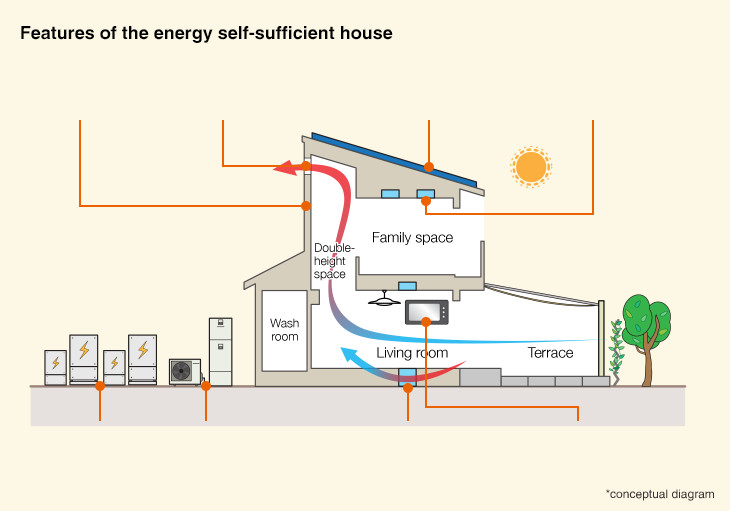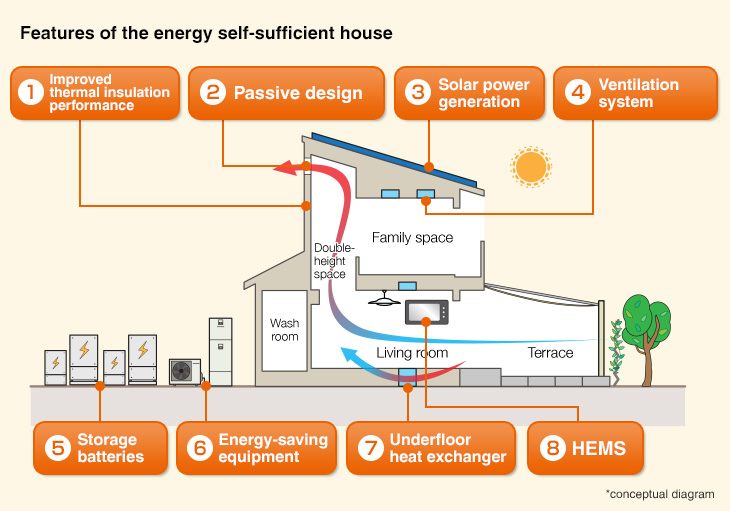SECUREA Toyota Kakimoto (Toyota City, Aichi Prefecture)Power interchange and energy self-sufficient houses

Deputy Mayor Motoaki Sugiyama of Toyota City (left)
and Managing Executive Officer Otomo of Daiwa House (right)
The development of SECUREA Toyota Kakimoto in Toyota City, Aichi Prefecture, has been completed. SECUREA Toyota Kakimoto is a town with 21 single-family, energy self-sufficient houses, where electricity is interchanged between the houses.
Outline
SECUREA Toyota Kakimoto has been officially opened as the sixth town of the SMA × ECO PROJECT,*1 which we proposed as a project in relation to the sale of property owned by Toyota City (Aichi), an environmental model city, and for which we were selected as the contractor.
In this town, a system, which enables residents to use energy reasonably, efficiently, and comfortably, is adopted. This is a smart town that aims to reduce its CO2 emissions and achieve peak-cut and peak-shift of its energy demand.
Specific features of the town include power interchange between single-family houses, a hybrid system combining a solar power generation system and lithium ion batteries (6.2 kWh), and a Home Energy Management System (HEMS) in every house; the SMA-ECO Cloud, a system for visualization of energy consumption in the entire town; and a solar power generation system over the retention basin. With these efforts, we are aiming to achieve a Net Zero Energy Town.*2
*1 A project to offer new value in the towns developed by our company
*2 A town where the annual net primary energy consumption is zero or almost zero as a result of the improvement of the energy saving performance of the skeletal structures and facilities of houses and the effective use of renewable energies.
- SECUREA Toyota Kakimoto (built-for-sale houses)
- SECUREA Toyota Kakimoto (building lots with building permits)

Plan of SECUREA Toyota Kakimoto
Power interchange operation between single-family houses within a town block
There is a limit to how much contribution a single house can make to energy saving. We enhance the effective use of energy and accompanying reduction of CO2 emissions by the collaborative efforts of the entire town block. One of the efforts based on this concept is power interchange among single-family houses in the block. There have been some examples of power interchange by block, but some of these projects required a special designation by the national government to provide specific power supply or, in some projects, a large-scale energy management system needed to be additionally built to achieve power interchange. Thus, power interchange involving all houses in a block has not yet been widely adopted.
In SECUREA Toyota Kakimoto, the entire power interchange block, consisting of the retention basin equipped with a solar power generation system, the lot for the SMA-ECO station where the community assembly hall is located, and the lot for three houses, is regarded as one unit of demand for electricity. Equipment and devices within the block are connected in such a way as to facilitate power interchange.
More specifically, with regard to the output from the solar power system and the output from the storage batteries in the power interchange block, Daiwa Energy Co., Ltd., a Daiwa House Group company, purchases the surplus from the community assembly hall and the entire output from the houses, and supplies the purchased electricity to places where there is a demand for electricity within the power interchange block.
When electricity falls short within the block, electricity is supplied by an electric power company, and when electricity generation is in excess of demand within the block, the electricity generated from the solar system alone is transmitted to the electric power company. Electricity is generated and consumed within the block to achieve “local production for local consumption” to reduce the consumption of the electricity supplied by an electric power company as much as possible.
The unified management by Daiwa Energy of the electricity generated and stored by the solar power generation system and the lithium ion batteries installed in the power interchange block enables us to improve the efficiency of the devices and ensure the stable supply of electricity.
The power interchange operation within the town block explained above is a new form of supply and demand of electricity for single-family houses. We will improve the system by reducing initial and maintenance costs as much as possible so that it can be used more widely.
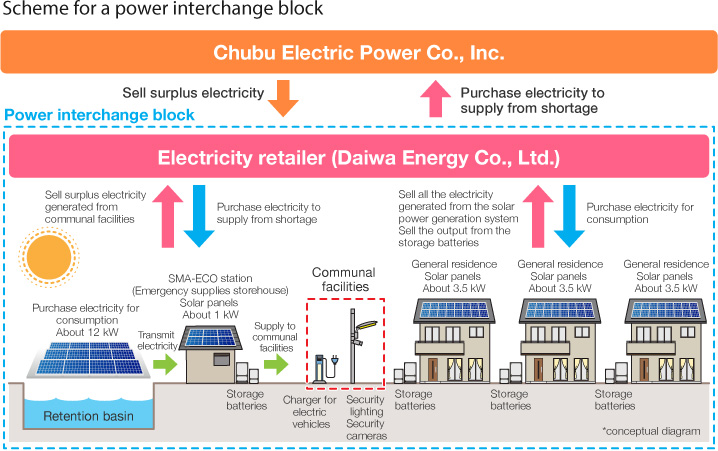
Effects and future development of power interchange
Storage batteries are designed to operate only when a certain level of electric power load is applied to prolong the life of the batteries. For this reason, the power consumption of three houses is combined to increase opportunities for the batteries to discharge electricity and to improve battery operation rates and the conversion efficiency at the time of discharge.
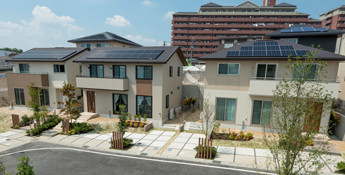
Under the current fixed price purchase system for renewable energy, the period covered by the fixed price program is ten years for an individual house installed with a solar power system of less than 10 kW. Under our project, the entire power interchange block is designated as one power generation unit and, therefore, a lower unit price for purchase is applied but the period covered by the program is 20 years. In addition, in this town block, unlike others, the entire amount of discharged electricity from the solar power system and storage batteries can be sold to Daiwa Energy Co., Ltd. During a power outage following a disaster or other emergency, residents can make effective use of the solar power system and lithium ion batteries in the block.
One of the success factors in this project is the well-balanced control of multiple storage batteries installed in different houses, which was achieved quickly thanks to the power interchange system developed through the cooperation among our Group companies. The actual data obtained in this project on electric power supply and demand and the effects of power interchange will be used effectively, and more efforts will be implemented to be prepared for further expansion of the scale in the future. In addition, to turn this project into an energy business, we will pursue an optimal energy supply and demand system for a town as a unit, taking into account the diversity of transaction forms, such as “negawatt transactions.”*1
*1 Trading of electricity, both generated and saved
*2 ELIIY Power:Invested in by our Group

Construction of an energy self-sufficient house, which is open to the public as a model house for one year after completion
The national government is promoting the construction of zero energy houses (ZEH). While the concept of ZEH is based on the assumption that the energy balance is ±0, energy self-sufficient houses are designed to reduce their electricity purchases as much as possible.
The energy self-sufficient house developed by our company is designed to minimize electricity consumption, instead of increasing the capacity of installed solar power systems. The energy consumption of the house is managed in such a way as to eliminate wasted energy and the electricity to be consumed is that generated by solar power systems and stored electricity. In developing the energy self-sufficient house, we tried to achieve a realistic price to facilitate its spread nationwide.
One of the features to reduce energy use is its water heater. Water heaters commonly used in households use low-rate night time power to heat water, and hot water is stored to be used during daytime hours. Our model heats water using electricity generated by the solar power system during the day. With this model, the electricity generated by the solar power system can be immediately used to heat water. In addition, the use of the water heater during the time when the outdoor temperature is high helps improve the efficiency of the water heater itself.
Surplus electricity from the solar power system is stored in batteries. While night time power is usually purchased to be stored and used during the day, our model is designed so that surplus electricity from the solar power system is stored during daytime hours to be used by the family at night.
In addition to the improvement of these devices and better thermal shielding performance, passive design also plays an important role. Passive design takes into account the reduction of the burden of the thermal environment by taking advantage of airflow and shade. The house is designed in such a way as to let hot air in the summer escape from a window installed over a double height room and to plant trees in the garden and install window shades to reduce the direct sunlight from coming into the room through the windows.
These various technologies applied to SECUREA Toyota Kakimoto enable us to reduce the capacity of the solar power system to 6.16 kW and achieve a house that can self-supply energy from spring through summer.
This energy self-sufficient house is open to the public as a model house for a year after the completion. We are planning to organize various kinds of events and workshops in the house.
(1) Improved thermal insulation performance
The high thermal insulation of the entire house maintains an environment comfortable in summer and winter, reducing air conditioning costs significantly.
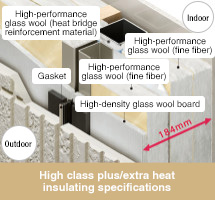
External heat-insulating and ventilating external wall Σ extra specification
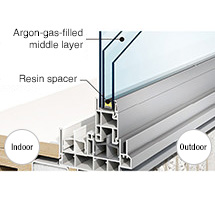
Resin sash
Back to “Characteristics of the energy self-sufficient house”
(2) Passive design
Passive design uses natural sources, instead of depending on such energies as electricity and gas, to control the flow of heat and air to achieve comfortable living in summer and winter.
In summer when the sun is high in the sky, the eaves and awning block incoming sunlight. Heat-shielding plates are applied to the pavement to reduce heat radiation, and green plants are used as a fence to achieve transpiration effects in order to reduce the heat flowing into the room. The double height space, without a partition, allows the warm air from the living room to escape through the window located up near the ceiling. In winter when the sun is low in the sky and the leaves of the plants on the fence are shed, the awning can be folded to allow sunlight to come into the room.
The effective use of ambient natural sources thus helps reduce the air conditioning load.
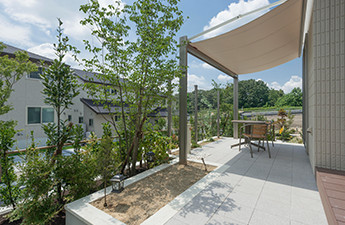
Heat shield awning, pavement with heat shield plates, greening fence
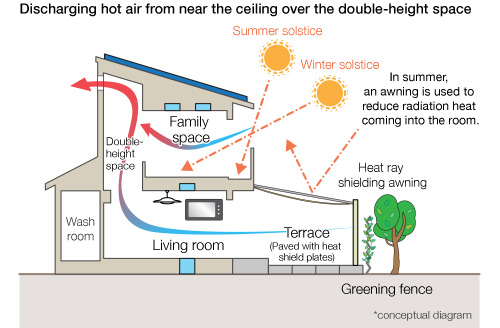
Back to “Characteristics of the energy self-sufficient house”
(3) Solar power generation
A solar power generation system is installed on the roof of a house to generate electricity using limitless clean solar light. The system not only helps reduce daily heating and lighting costs but also is useful in case of power outage. The energy self-sufficient houses in this project are installed with a 6.16 kW system.
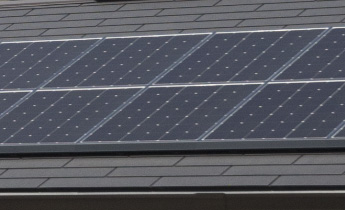
Back to “Characteristics of the energy self-sufficient house”
(4) Ventilation system
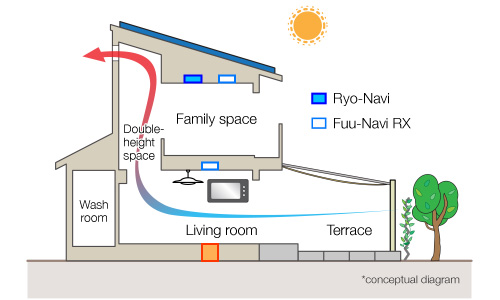
Ryo-Nabi
In spring and fall, ascending warm air in the ambient environment is used to expel the heat from the room to the outside, helping reduce the use of air conditioning. In summer, ventilation fans are operated automatically to force out the heat. In winter, dampers are closed to prevent cold air from entering the room.
Fuu-Nabi RX
A heat exchanger type 24-hour ventilation system that adjusts the temperature of the outside air close to that of the air inside the room before supplying it. This system maintains a comfortable air environment and also contributes to reduced energy use by air conditioning systems.
Back to “Characteristics of the energy self-sufficient house”
(5) Lithium ion battery
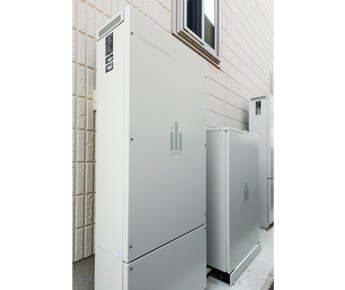
POWER iE 6 HYBRID (manufactured by ELIIY Power Co., Ltd.)
A long-life, lithium-ion battery with high charge and discharge efficiency. The energy self-sufficient house in this project is connected to two units of a hybrid system (6.2 kWh) combining this storage battery and a solar power generation system (12.4 kWh in total).
(6) Energy-saving equipment
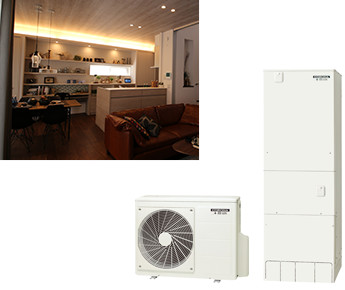
LED lighting and EcoCute
Energy-saving equipment designed to ensure comfortable living with less energy, such as a heat pump water heater (EcoCute) and LED lighting, is used.
Back to “Characteristics of the energy self-sufficient house”
(7) Underfloor heat exchanger
A system that supports air conditioning by taking advantage of cool air under the floor in summer.
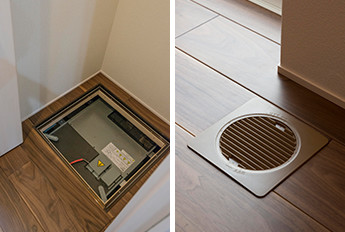
Body of the underfloor heat exchanger/air outlet
Back to “Characteristics of the energy self-sufficient house”
(8) Home Energy Management System (HEMS)
D-HEMS 3, the original home energy management system of our company, visualizes home energy consumption to help the entire family enjoy energy saving with the help of its function to check the level of energy saving achievement and to give the user energy saving advice and tips. In addition, the system centrally controls air conditioning units and lighting systems to prevent waste from forgetting to turn them off.
A system called SMA-ECO Cloud is also available to collect data from each house to visualize the energy consumption of the entire town. This system allows the users to check the state of energy consumption of the entire town and compare their data with other smart towns developed by our company throughout the nation.
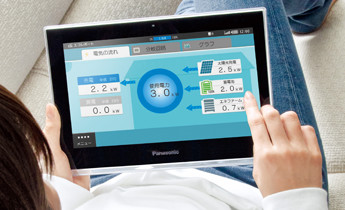
D-HEMS 3, which visualizes home energy consumption
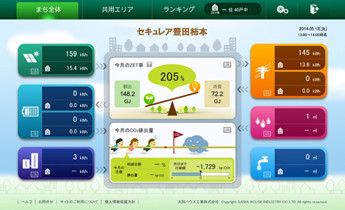
SMA-ECO Cloud, which visualizes the energy consumption of the entire town
Back to “Characteristics of the energy self-sufficient house”
SMA-ECO station
The SMA-ECO station is built beside the retention basin in the town block to supply electricity that is generated by the solar power system installed over the retention basin and electricity that is stored in lithium ion batteries to battery chargers for electric vehicles (EVs) and security lighting (street lights).
In preparation for emergencies, tools useful in an emergency are stored in the emergency storage facility installed in the SMA-ECO station. If lifelines are disrupted temporarily after a disaster, electricity generated by the solar power system installed over the retention basin and electricity stored in the SMA-ECO station can be used as emergency power.

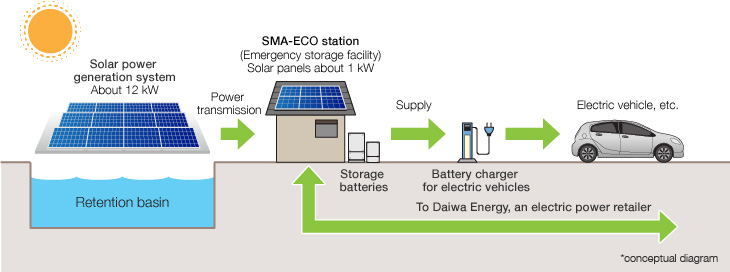
Landscape agreement and undergrounding of overhead cables
To maintain the totally coordinated landscape design for the town that was adopted when the town was planned and to maintain the town’s value, we have developed the SECUREA Toyota Kakimoto Landscape Agreement and the town development guidelines.
Power transmission cables are installed underground so that power poles and wires do not spoil the landscape of the town and people can enjoy a sweeping view of the sky.
In addition, by placing power cables underground, there is no risk of cable disconnection due to the collapse of power poles and trees in a disaster, ensuring improved safety.

Comment from the Mayor of Toyota City
Give citizens information on the advantages of a future city and encourage them to incorporate them in their lifestyles
Toyota City, which is designated as an environmental model city, aims to achieve a society in which its residents can enjoy an ecological lifestyle reasonably, efficiently and comfortably. SECUREA Toyota Kakimoto consists of smart houses equipped with solar power generation systems, HEMS, and storage batteries, which Toyota City is encouraging its residents to use. In SECUREA Toyota Kakimoto, all the houses are energy self-sufficient and adopt a power interchange system. These and other features of a future city are adopted in this project. I expect that these advanced efforts will help encourage our citizens to incorporate these features into their lifestyles and help attract more people to settle in Toyota City.
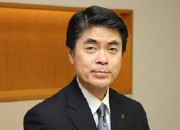
Toshihiko Ota
Mayor of Toyota City
Comment from Branch Manager
Achieve power interchange and an energy self-sufficient house, and provide people with information on the advantages of the house to spread its use
The collaboration among Daiwa House Group’s companies and others enabled the speedy completion of the SECUREA Toyota Kakimoto project where a cutting-edge system for power interchange operation and an advanced energy self-sufficient house are included. The energy self-sufficient house will be open to the public as a model house for a year after its completion. We are planning to organize various kinds of events and workshops in the house to publicize the advantages of the town to people from Toyota City and other places. We will continue our efforts to promote net zero energy towns that place great emphasis on environmental considerations.
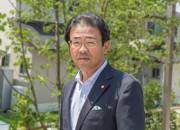
Hiromi Suzuki
Toyota Branch Manager Daiwa House
Comment from a member of the development team
Many customers in Toyota City are highly environmentally conscious and take it for granted that new houses are equipped with environmentally conscious items, such as solar power systems and storage batteries. I believe that even they find the power interchange system and the energy self-sufficient house in SECUREA Toyota Kakimoto innovative and unprecedented. I will provide customers with detailed explanations of our efforts at study tours and events held in the energy self-sufficient house to help them better understand the advantages of our energy self-sufficient house in order to promote the spread of the energy self-sufficient house, in addition to ZEH, which has already been promoted.

Kenya Takahashi
Residential Sales Manager, Toyota Branch Daiwa House
Comment from a member of the development team
I was involved in the entire project of town development as an onsite staff member. Through experiencing the development of a system to introduce and maintain cutting-edge technology in the town, I was able to acquire a lot of expertise.
We had many difficulties particularly in implementing power interchange at a low voltage level, which is the first of its kind in our company’s smart towns. As a result of the concerted efforts of the Daiwa Group companies and others, however, we have successfully overcome the difficulties. To achieve the autonomy of the town, we have developed a system for forming and organizing an incorporated housing complex association.
As a member of a group to jointly create value, I will develop towns that satisfy many people based on experience and technology I have gained in this project.
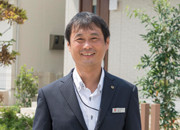
Tomonori Inoue
Chief, Osaka Urban Development Department Daiwa House











